Alex Clements, individual and team World Champion with Drennan Team England Under 23s, looks back on an unforgettable weekend on Portugal’s River Sorraia in Coruche.
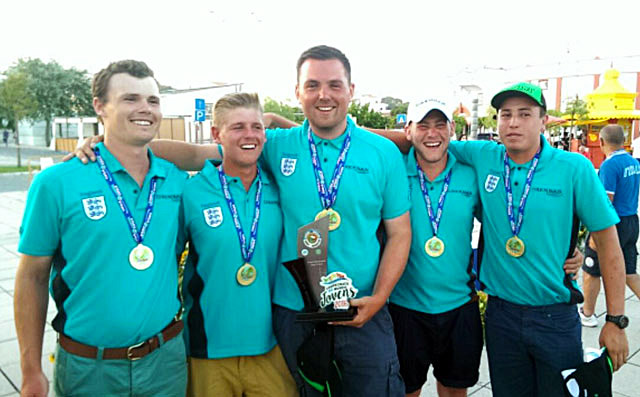
Midge bites, soaring temperatures and lava sand – but I would do it all again tomorrow to re-live the moment we found out we were World Champions!
 This was by far the most testing World Championship I have had the privilege to fish but it certainly did not disappoint. The venue, the people and the country were all magnificent. There was not a single fault and I know for a fact that myself and the team thoroughly enjoyed ourselves. Having a medal around our necks – and especially a gold one – was simply unthinkable at the start of the week due to the nature of this venue and the fact that it’s never been a happy hunting ground for England.
This was by far the most testing World Championship I have had the privilege to fish but it certainly did not disappoint. The venue, the people and the country were all magnificent. There was not a single fault and I know for a fact that myself and the team thoroughly enjoyed ourselves. Having a medal around our necks – and especially a gold one – was simply unthinkable at the start of the week due to the nature of this venue and the fact that it’s never been a happy hunting ground for England.
There were a lot of factors to deal with, such as the sandy banks of Coruche making setting up a rather difficult process. The heat was unbelievable and walking bare-footed on the sand was suicide, so we all favoured a pair of Crocs. Also digging out the peg was tricky, as we had to stop our seatboxes from sinking into the sand!
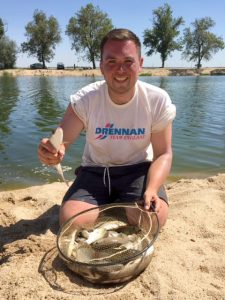 Of course, the fishing also had its factors as we were looking to catch barbel, carassio and mullet; species we rarely get to fish for in England. Different methods were also needed to catch these species, such as a fixed waggler for the barbel but set up to 11ft deep when the venue was only around 7-8ft in most places!
Of course, the fishing also had its factors as we were looking to catch barbel, carassio and mullet; species we rarely get to fish for in England. Different methods were also needed to catch these species, such as a fixed waggler for the barbel but set up to 11ft deep when the venue was only around 7-8ft in most places!
During the practice sessions at the start of the week things were looking really bleak where we had drawn towards the town as there seemed to be very few fish. It wasn’t until the third day of practice when a team plan really started to come together.
Drawing practice Box 1 we were at the much better end of the match length where good weights had been recorded by other teams. After the previous two difficult days we had no idea what to expect. We noticed we were getting a lot of missed bites which we now know were from bleak and small barbel. Trying to assemble a method to catch these fish was starting to look necessary as the fishing was likely to be hard. We also started to realise that feeding hemp helped to keep the fish down and feeding maggots obviously made it worse – but our third day changed our whole perspective!
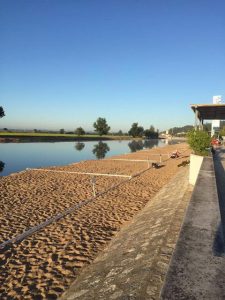 Coaches Mark Downes and Darran Bickerton had us using different mixes and feeding different amounts to try and gauge a picture of what worked best, so mixes that included soil and excluded it were both tried. It wasn’t long before we were all catching carrasio and we quickly noticed that the more positive you were the more you would catch.
Coaches Mark Downes and Darran Bickerton had us using different mixes and feeding different amounts to try and gauge a picture of what worked best, so mixes that included soil and excluded it were both tried. It wasn’t long before we were all catching carrasio and we quickly noticed that the more positive you were the more you would catch.
By the end of the session we had all caught between 3kg and 7kg and were suddenly walking around feeling much more confident! In our meeting that night you could tell we all felt like a weight had been lifted from our shoulders. Also, the prospect of targeting mullet on the waggler might not be as important as we previously thought was a sigh of relief.
Feeding
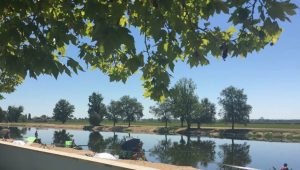 Our plan consisted of feeding a sticky and heavy groundbait mix on the long pole, which when squeezed hard enough didn’t let anything off on the way down. This minimised fish rising off the bottom and consequently helped to reduce missed bites. We decided on two bags of Sensas Lake, two bags of Fine Carp and a bag of Terre de Rivière. At the start we fed between four and eight balls depending on where we drew. Roughly 250ml of feed was added to the initial feed, which included maggots, hemp, worm and joker. I felt topping up was best done as soon as you caught anything other than a carrasio or whenever the teams next to you topped up. At times I topped up with three balls just to keep the fish in my peg.
Our plan consisted of feeding a sticky and heavy groundbait mix on the long pole, which when squeezed hard enough didn’t let anything off on the way down. This minimised fish rising off the bottom and consequently helped to reduce missed bites. We decided on two bags of Sensas Lake, two bags of Fine Carp and a bag of Terre de Rivière. At the start we fed between four and eight balls depending on where we drew. Roughly 250ml of feed was added to the initial feed, which included maggots, hemp, worm and joker. I felt topping up was best done as soon as you caught anything other than a carrasio or whenever the teams next to you topped up. At times I topped up with three balls just to keep the fish in my peg.
We had also set up a short pole line at six metres where we fed a ball of stickymag and a ball of groundbait to catch barbel and carrasio, but on my two match days I never had to look there. The catapult also played a part, but only feeding hemp to attract fish if it was hard. As soon as the fish arrived it was simply a case of topping up aggressively.
The Pole Rigs
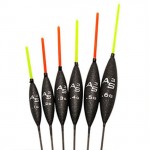 Five rigs were assembled to cover the short and long lines, all with No5 solid elastic. The first rig was a Drennan AS3 or Chianti in sizes 0.2g and 0.4g tied on 0.12mm Drennan Double Strength. These were set up with a simple strung bulk, so you could catch on the drop and work a bait through the water column.
Five rigs were assembled to cover the short and long lines, all with No5 solid elastic. The first rig was a Drennan AS3 or Chianti in sizes 0.2g and 0.4g tied on 0.12mm Drennan Double Strength. These were set up with a simple strung bulk, so you could catch on the drop and work a bait through the water column.
The next three rigs were more positive and all tied on 0.14mm Double Strength with Perfect Gloucester pole floats in sizes 1g, 1.25g and a 1.5g. These had a bulk of three No9 shot right next to the hooklength loop and main bulk set eight inches above that. This ‘double bulk’ arrangement proved deadly to show any bites on the drop but to also get your bait past the smaller fish.
The Waggler

 Our final line was a long-distance, fixed, loaded waggler at around 65 reel turns where we were looking to catch barbel on sticky mag from between 2oz and 4lb. A very complex set up was needed for these fish due to the clear water and the fact that this is a natural water commercial fishery. We quickly learnt that the barbel were very streetwise and catching them on tiny size 22 and 24 Kamasan B520 hooks was far better than other patterns. Pairing these with 0.10mm and 0.12mm Drennan Supplex Fluorocarbon proved by far the best hooklength.
Our final line was a long-distance, fixed, loaded waggler at around 65 reel turns where we were looking to catch barbel on sticky mag from between 2oz and 4lb. A very complex set up was needed for these fish due to the clear water and the fact that this is a natural water commercial fishery. We quickly learnt that the barbel were very streetwise and catching them on tiny size 22 and 24 Kamasan B520 hooks was far better than other patterns. Pairing these with 0.10mm and 0.12mm Drennan Supplex Fluorocarbon proved by far the best hooklength.
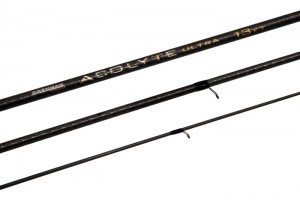 A soft action rod was also important and I favoured an Acolyte 13ft Ultra, which managed big wagglers with no problems and I never got snapped off once! Interestingly, we also incorporated a foot-long piece of solid No8 elastic into the rig to act as a boom and to stop any breakages on the take from the bigger barbel. This sat around 2-3ft below the waggler and was just attached using a swivel at both ends. Tied onto this swivel was a metre of 0.15mm Supplex Flurocarbon and then another swivel with the hooklength attached. We opted for 4.5lb Maxima main line as it was extremely important to achieve static presentation to get any bites. If the waggler moved you didn’t get a bite!
A soft action rod was also important and I favoured an Acolyte 13ft Ultra, which managed big wagglers with no problems and I never got snapped off once! Interestingly, we also incorporated a foot-long piece of solid No8 elastic into the rig to act as a boom and to stop any breakages on the take from the bigger barbel. This sat around 2-3ft below the waggler and was just attached using a swivel at both ends. Tied onto this swivel was a metre of 0.15mm Supplex Flurocarbon and then another swivel with the hooklength attached. We opted for 4.5lb Maxima main line as it was extremely important to achieve static presentation to get any bites. If the waggler moved you didn’t get a bite!
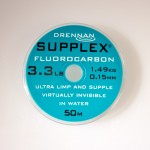 Feeding this line at the start was also incredibly interesting. We had noticed other countries skimming their stickymag across the top. When we sat down to think about this it made perfect sense to help create a larger feed area. Skimming it was perfect as the ball would bounce and slowly break up over a 10-15 metre radius that you could reel back over to search the area.
Feeding this line at the start was also incredibly interesting. We had noticed other countries skimming their stickymag across the top. When we sat down to think about this it made perfect sense to help create a larger feed area. Skimming it was perfect as the ball would bounce and slowly break up over a 10-15 metre radius that you could reel back over to search the area.
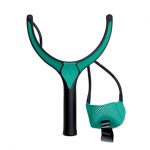 The green Drennan Softfeed Groundbait Catys fitted with soft black latex and a Drennan mesh pouch proved most accurate and didn’t rip the ball up on the way out. Topping up, however, was done by simply feeding a ball but not skimming it and just simply winding the float back over it. This seemed to catch the bigger barbel because we believed they shied away from the float. This is also why you wanted so much line on the bottom.
The green Drennan Softfeed Groundbait Catys fitted with soft black latex and a Drennan mesh pouch proved most accurate and didn’t rip the ball up on the way out. Topping up, however, was done by simply feeding a ball but not skimming it and just simply winding the float back over it. This seemed to catch the bigger barbel because we believed they shied away from the float. This is also why you wanted so much line on the bottom.
Looking Back
 There was one section of the match length that proved different to the rest and this was D Section where we had practised at the start of the week. This was predominately a big fish area where you had to fish the waggler and hope to catch barbel. Other than this section it proved an incredibly fair stretch with no end pegs dominating.
There was one section of the match length that proved different to the rest and this was D Section where we had practised at the start of the week. This was predominately a big fish area where you had to fish the waggler and hope to catch barbel. Other than this section it proved an incredibly fair stretch with no end pegs dominating.
The team this year worked fantastically together and we all carried each other to the end. It was a credit to be in the company of such great, young, talented anglers. I know I’ll have these boys as my friends for the rest of my life and I just want to thank them for their support through the week: Matthew Barnett, Rory Jones, Ricky Marshall and Bradley Gibbons. Not forgetting managers Mark Downes and Darran Bickerton. A huge thank you has to go to Drennan and Sensas as well for making this event possible for us to fish. The experience and the anglers that these events help create will last forever in our memories. A last shout out to Bordon Angling Centre for their continued support towards myself and Matthew Barnett.
